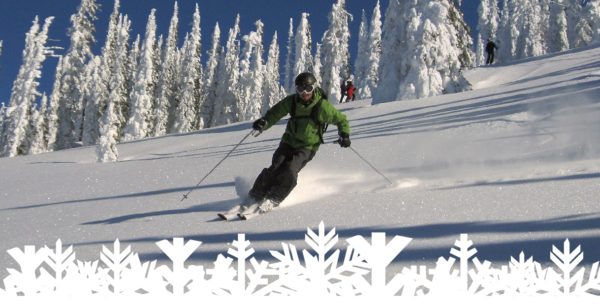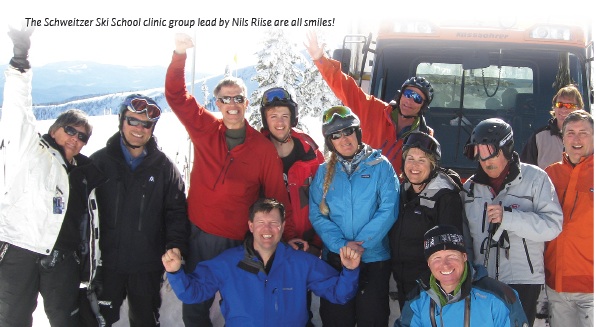A Clinic to Remember
by Nils Riise, photos by Chip Kamin
 When I got the call to confirm my two day member school clinic at Schweitzer, I had no idea what I was in for. I was totally stoked to be leading a Telemark clinic and an Alpine clinic all in the same weekend, let alone what I actually experienced. The call came just two days before I was supposed to leave for Idaho, so I wondered if the clinics had been cancelled. But, come to find out, at the end of that phone call I had entered into a whole new level of stoke.
When I got the call to confirm my two day member school clinic at Schweitzer, I had no idea what I was in for. I was totally stoked to be leading a Telemark clinic and an Alpine clinic all in the same weekend, let alone what I actually experienced. The call came just two days before I was supposed to leave for Idaho, so I wondered if the clinics had been cancelled. But, come to find out, at the end of that phone call I had entered into a whole new level of stoke.
I had been informed by the Schweitzer Snowsports School clinic organizer, that they had received a substantial amount of snow over the last week, and with clear weather in the forecast, we’re changing plans. He asked me if it was o.k. with me if one of the clinic days took place in the backcountry. I then proceeded to tell him that I was ready to work with his folks needs anywhere they saw fit and that I would bring my skins and backcountry ski gear. He said, “That won’t be necessary, ‘cause we have arranged a snow cat for you and your group.” I thought, “Really, snow cat skiing for a member ski school clinic? No Way!”
“Are you serious?” I said. “Yup, just arrive at the ski school at 8:00 am Saturday morning ready to ski powder. See you then!” Chip hung up. I had just walked into a dream clinic. Cat skiing all day – on the house, coaching folks on powder skiing and getting paid? Wow, pinch me, I’m dreaming! Here’s how it all went down:
During my drive out there, in the back of my mind I kept on doubting that the snow cat trip was actually going to happen. So, I arrived early to make sure this all just wasn’t a hoax. “Maybe someone was just playing a big joke on me,” I thought. Was I actually about to embark on a snow cat trip for a member school clinic? I had no idea what to expect. How and where were we going to access this Schweitzer backcountry? From my previous experience with cat trips I was ready for a 30-60 minute van ride to our pick up point. I was just told to show up and follow along with the rest of the group.
After our avalanche safety briefing, we were all gathered at the clock tower in the base area for our van ride or whatever the next phase in the trip was and along comes our lead guide, Chip Kamin. “O.K. you guys, are your transceivers on? Are you all ready to go?” he says all nonchalant. At this point, I am still looking around for our ride. Then, Chip proceeds to announce to the group, “Let’s head over to the Great Escape Quad and get up to our starting point, we’ve got to meet up with our other guide, Ken.” At this point I ask the clinic participants, “Where are we going, how are we getting to the snow cat?” They all just looked at me kind of funny and said, “We’re starting up on top.” For some reason, I just didn’t pick up on the fact the cat skiing operation actually operated from the top of the ski area. Go figure – duh, Nils. I guess it had been a while since I had skied Schweitzer. Big changes – what a cool concept, sure why wouldn’t it be based on top, right?
As we crested the top of the Great Escape Quad, there it was, all gleaming in the morning sunlight, sitting proud and awaiting our arrival, Selkirk Powder Company’s snow cat. Again I’m thinking, “O.k. now, pinch me again – really? This is so rad, I can’t believe it.” All you do is ski off the quad and slide straight ahead to the Selkirk Powder Lodge and “boom” you’re ready to go.
After meeting Ken and a short meeting about the day’s logistics we were traversing out to our first pitch. The experience to this point had been so low key and enjoyable. Chip and Ken had done such a great job prepping and briefing the group that we all just flowed right into the forested backcountry like a pack of hobbits. I got so wrapped up in the experience of ripping pow in the sunshine with these great people that I almost forgot that I was supposed to be giving a clinic. I realized I had to quickly figure out how to set the stage for learning without constraining the excitement everyone had for skiing untracked powder in the sunshine all day. It worked out great.
 We had a total of eight people and would be making at least eight or nine runs, so at the very least I figured I could coach each person one on one, one run at a time. How it worked out was actually a combination of that idea and intermittently working in two to three person pods. I grouped the pods according to ability for some runs and also gender. I wanted to make sure that the women in the group felt supported to move down the hill and learn at their own pace without the testosterone driven vibe of the guys. But then, I also had to keep the dudes in the group happy too. So, my approach with them was around giving them focused and concise coaching, so as not to affect their unbridled energy and flow. This was also the first time I had worked with people skiing on rockered skis too. What those skis can do for flotation is amazing. A couple of the women in the group were skiing on the rockered skis without much experience or confidence in powder. The results they achieved after just a couple runs of coaching were quite remarkable.
We had a total of eight people and would be making at least eight or nine runs, so at the very least I figured I could coach each person one on one, one run at a time. How it worked out was actually a combination of that idea and intermittently working in two to three person pods. I grouped the pods according to ability for some runs and also gender. I wanted to make sure that the women in the group felt supported to move down the hill and learn at their own pace without the testosterone driven vibe of the guys. But then, I also had to keep the dudes in the group happy too. So, my approach with them was around giving them focused and concise coaching, so as not to affect their unbridled energy and flow. This was also the first time I had worked with people skiing on rockered skis too. What those skis can do for flotation is amazing. A couple of the women in the group were skiing on the rockered skis without much experience or confidence in powder. The results they achieved after just a couple runs of coaching were quite remarkable.
I found that regardless of what kind of skis my people were on that day, how I coached them didn’t really change. The basic concept of keeping the feet working together under the body in the powder still holds true, as well as using simultaneous feet and leg movements for steering, pressuring or edging – this was paramount for their success. That said, what I noticed the most, when working with the women who had minimal experience in the powder was that the rockered skis allowed them to experiment more freely with changing their technique without the fear of falling or losing control. Also, the feedback they experienced from the ski/snow interaction was positive and immediate. Meaning, they improved quickly and went from being unbalanced and inconsistent with their turns, to putting together full length rhythmical series of turns together without falling.
Another simple element that I worked on with everyone in the group was focusing on complementary hand and arm movements. One of the most important elements of powder skiing technique is a strong and rhythmical pole plant. So, what I introduced to them was what I call the ready pole concept. We began with making shallow turns in the falline on low angle terrain. Then, we focused on swinging the inside hand, arm and pole directly down the fall line ahead of the current turn shape in preparation for the next pole plant. As the skiers gained confidence with this concept we experimented with steeper longer pitches and added a little more shape to the turns to control speed. The result of this little drill promoted continual directional movements of the center of mass toward the new turn and kept the skiers balanced over their feet. And of course, a strong inside half resulted, which positively affected their balance over their line of action and hand and arm movements that compliment body movements.
Progressively throughout the day the smiles got bigger and bigger by focusing on these two concepts – Continuous and simultaneous movements of the feet and legs timed with a strong rhythmical pole swing and pole plant.
At the end of the day, we all had bonded well together and had a fabulous day. The powder mystery had been solved for some and the hunger for powder in a low snow year had been satisfied for all. For me, I had one of the best days of my coaching career as well as a powder day that easily rated in my top ten days of all time.
I am so thankful to the staff at Schweitzer Ski and Snowboard School for including me on their cat trip and to Chip and Ken of Selkirk Powder Company for making the whole day cool, groovy and safe. I look forward to working with all of them again. Cheers.
[connections_list id=18 template_name=”div_staff_bio”]
